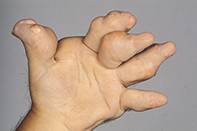Peer Reviewed
Rheumatology clinic
An approach to gout: tailoring strategies to difficult situations
Abstract
Gout is usually easy to recognise and simple to manage, yet errors in diagnosis and treatment remain common. In this article, Dr McGill describes his approach to difficult management situations.
Key Points
What is gout?
Gout is a painful metabolic disorder caused by the presence of urate crystals in a joint. Crystal formation requires hyperuricaemia and the correct balance of promotors and inhibitors affecting crystallisation at the site of deposition, and occurs over weeks to months with no immediate clinical effect.
An attack of acute gout is caused by interaction between urate crystals and the inflammatory system – joint pain develops abruptly and is accompanied by redness and swelling. After an attack, the crystals remain in the joint. Tophi usually appear after many years but may appear earlier in the distal interphalangeal joints of postmenopausal women, and irreversible joint damage becomes apparent at about this stage (Figure).

